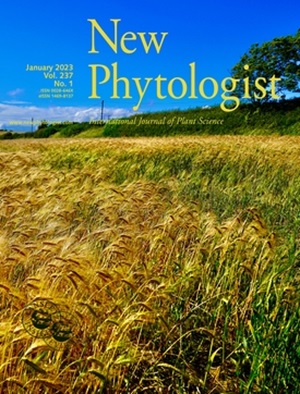Flavodiiron proteins associate pH-dependently with the thylakoid membrane for ferredoxin-1-powered O2 photoreduction
IF 8.3
1区 生物学
Q1 PLANT SCIENCES
引用次数: 0
Abstract
- Flavodiiron proteins (FDPs) catalyse light-dependent reduction of oxygen to water in photosynthetic organisms, creating an electron sink on the acceptor side of Photosystem I that protects the photosynthetic apparatus. However, ambiguity about the electron donor(s) remains, and the molecular mechanisms regulating FDP activity have remained elusive.
- We employed spectroscopic and gas flux analysis of photosynthetic electron transport, bimolecular fluorescence complementation assays for in vivo protein–protein interactions in the model cyanobacterium Synechocystis sp. PCC 6803, and in silico surface charge modelling.
- We demonstrated that ferredoxin-1 interacts with Flv1, Flv2, and Flv3, and is the main electron donor to FDP heterooligomers, which are responsible for the photoreduction of oxygen. Moreover, we revealed that FDP heterooligomers dissociate from the thylakoid membrane upon alkalisation of the cytosol, providing the first in vivo evidence of a self-regulatory feedback mechanism allowing dynamic control of FDP activity and maintenance of photosynthetic redox balance in fluctuating environments.
- Our findings have direct implications for rationally directing electron flux towards desired reactions in biotechnological applications.
黄二铁蛋白与类囊体膜的ph依赖性相关联,用于铁氧化还原蛋白-1驱动的O2光还原。
黄二铁蛋白(FDPs)在光合生物中催化氧气的光依赖性还原为水,在光系统I的受体侧产生一个电子汇,保护光合装置。然而,关于电子供体的不确定性仍然存在,调控FDP活性的分子机制仍然难以捉摸。我们采用光谱学和气体通量分析光合电子传递,双分子荧光互补分析模型蓝藻Synechocystis sp. PCC 6803的体内蛋白质-蛋白质相互作用,以及硅表面电荷模型。我们证明了铁氧化还原蛋白-1与Flv1, Flv2和Flv3相互作用,并且是FDP异聚物的主要电子供体,这些异聚物负责氧的光还原。此外,我们揭示了FDP异聚物在细胞质碱化时从类囊体膜分离,这为自我调节反馈机制提供了第一个体内证据,该机制允许动态控制FDP活性并维持波动环境中的光合氧化还原平衡。我们的发现对合理地将电子通量导向生物技术应用中的期望反应具有直接意义。
本文章由计算机程序翻译,如有差异,请以英文原文为准。
求助全文
约1分钟内获得全文
求助全文
来源期刊

New Phytologist
生物-植物科学
自引率
5.30%
发文量
728
期刊介绍:
New Phytologist is an international electronic journal published 24 times a year. It is owned by the New Phytologist Foundation, a non-profit-making charitable organization dedicated to promoting plant science. The journal publishes excellent, novel, rigorous, and timely research and scholarship in plant science and its applications. The articles cover topics in five sections: Physiology & Development, Environment, Interaction, Evolution, and Transformative Plant Biotechnology. These sections encompass intracellular processes, global environmental change, and encourage cross-disciplinary approaches. The journal recognizes the use of techniques from molecular and cell biology, functional genomics, modeling, and system-based approaches in plant science. Abstracting and Indexing Information for New Phytologist includes Academic Search, AgBiotech News & Information, Agroforestry Abstracts, Biochemistry & Biophysics Citation Index, Botanical Pesticides, CAB Abstracts®, Environment Index, Global Health, and Plant Breeding Abstracts, and others.
 求助内容:
求助内容: 应助结果提醒方式:
应助结果提醒方式:


